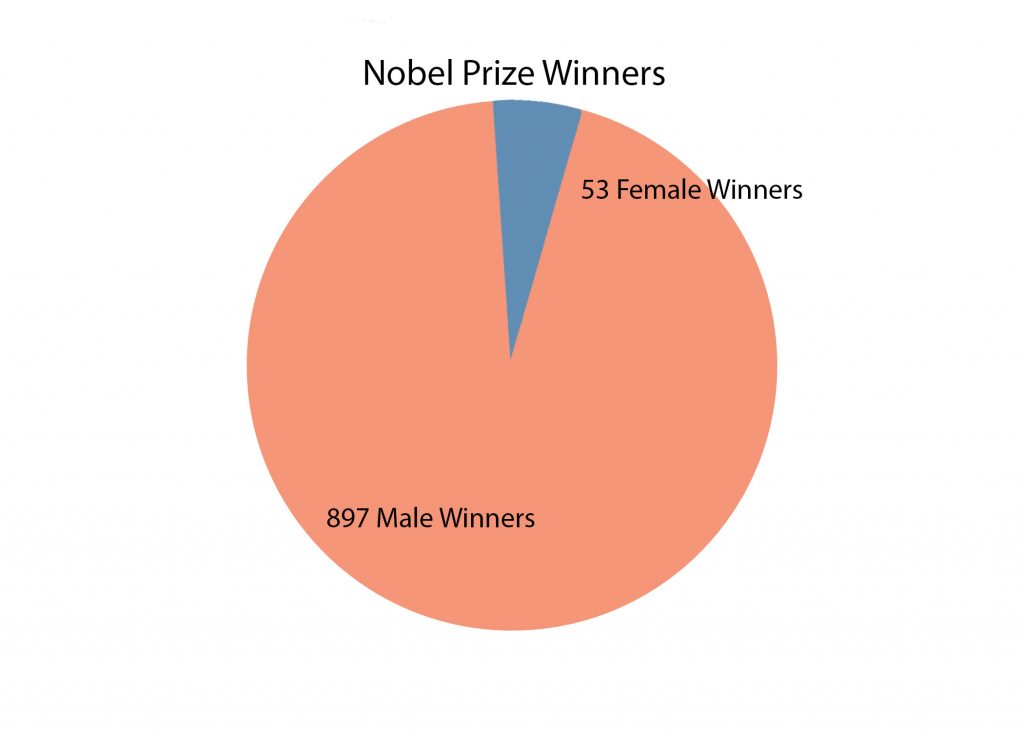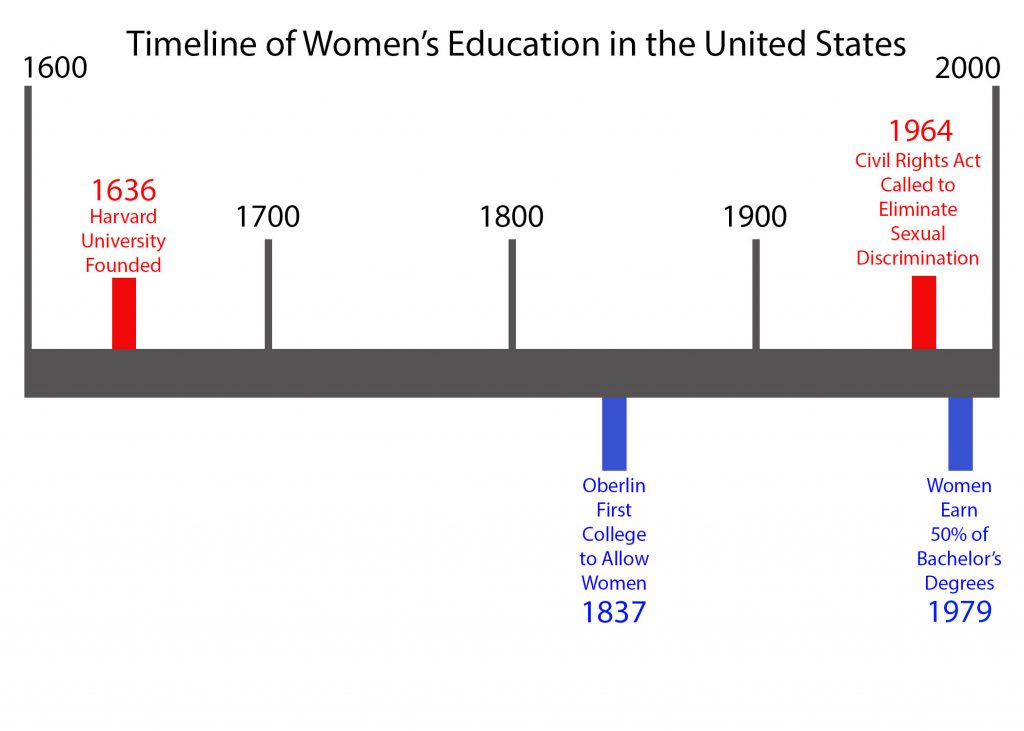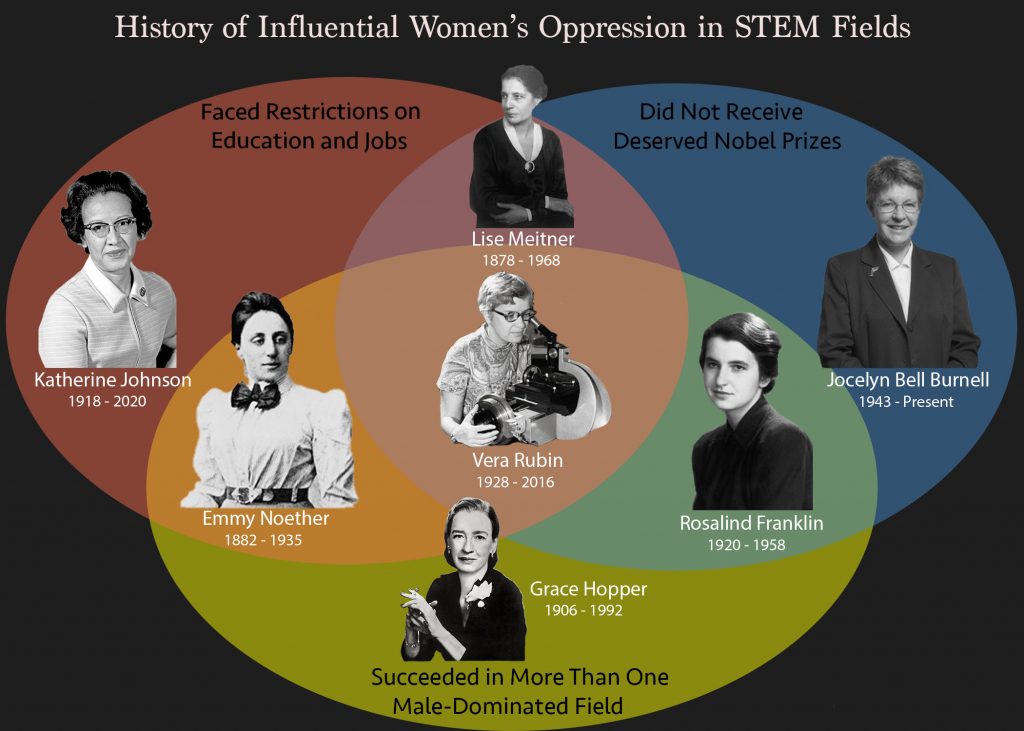Women are oppressed in STEM fields in many different ways, such as facing restrictions on their education/jobs and a lack of recognition for the same achievements their male colleagues have received recognition for. This is especially evident with Nobel Prize winners:

Out of 950 winners of Nobel Prizes, 53 were women, making the percentage of female winners 5.6%. (Casey McGrath ’23)
In spite of sexism, some women have overcome these obstacles and succeeded in one, or even two male-dominated STEM fields. Below, I provide short blurbs on each of the seven women featured in my diagram above.
Jocelyn Bell Burnell discovered the existence of pulsars while working under her supervisor at Cambridge University, a discovery that is considered one of the most significant in astronomy of the 20th century. In 1974, her supervisor was awarded the Nobel Prize in Physics for the discovery; she was not. Photo Credit: Royal Society, Edinburgh.
Rosalind Franklin was a physicist and a chemist whose work on DNA and x-ray diffraction was essential to Watson and Crick’s discovery of the structure of DNA. She also contributed ground-breaking research on the polio vaccine. Watson and Crick failed to properly credit her for her contributions, and she passed away before they were awarded the Nobel Prize in 1962, making her ineligible to receive the award. She died without ever being fully recognized for her contributions to the fields of chemistry and physics. Photo Credit: Elliot and Fry, Natural Portrait Gallery.
Grace Hopper was one of the very first computer scientists to contribute to the development of computer languages, and she joined the Navy during World War II, eventually rising to the rank of admiral. These successes were especially significant because both fields (computer science and the U.S. Navy) were dominated by men and were known to be exceptionally hard for women to succeed in. Photo Credit: Shorpy, American Historic Photo Archive.
Katherine Johnson hand calculated the orbital trajectories for NASA’s most famous space expeditions, and John Glenn famously refused to go into space until Johnson calculated the trajectory of his mission herself. She was unable to attend graduate school until 1939, when she was hand- selected by West Virginia University’s president as the one of the first three black students and the first black woman to attend the university. Photo Credit: NASA.
Lise Meitner helped in discovering nuclear fission, and gave the first theoretical explanation for the process. Due to restrictions on higher education for women in Austria, she was not able to go to university until 1901. She worked with her partner Otto Hahn in the discovery of nuclear fission, and Hahn was awarded the Nobel Prize in Chemistry in 1945; Meitner was not. Photo Credit: Anne Meitner, Lotte Meitner-Graf.
Emmy Noether made significant contributions to the field of abstract algebra, and discovered Noether’s Theorem, which explained problems that arose from Einstein’s Theory of General Relativity. She was forbidden to attend university to become a mathematician, and was not granted permission to pursue a PhD until 1904. When she first became a professor, she did not receive a salary because people protested about a woman teaching university men. Photo Credit: SPL, Photo Researchers.
Vera Rubin was proficient in math, physics, and astronomy, and discovered the first case of real evidence for the existence of dark matter, effectively confirming its existence and ushering in a new era of astrophysics and astronomy. She attempted to enroll at Princeton for a graduate degree, but was not permitted because of her gender, and frequently had to fight to be permitted to use facilities at observatories for her research due to her gender. Throughout the years, even as recently as 2019, physicists have been awarded Nobel Prizes for their theories surrounding dark matter, but Vera Rubin was never recognized by the Nobel Committee for her work in making those theories even possible. Photo Credit: Carnegie Institute of Washington.
These women were at the forefront fighting for their right to receive educations in STEM fields and achieve recognition for their contributions. While many of them would be happy to see the new gains in gender equality that women have gotten in recent years, women are still vastly underrepresented in STEM fields and continue to face obstacles every day preventing them from achieving all that they can.

The rates of women receiving higher education in the US only started to reach the same rates as men in the last forty years. (Casey McGrath ’23)
Sources
“Famous Scientists: The Art of Genius” Famous Scientists, www.famousscientists.org/
“Lise Meitner: A Battle for Ultimate Truth”, Science Women, https://www.sdsc.edu/ScienceWomen/meitner.html
“Grace Murray Hopper (1906-1992): A Legacy of Innovation and Service.” YaleNews, 27 Feb. 2017, https://news.yale.edu/2017/02/10/grace-murray-hopper-1906-1992-legacy-innovation-and-service
Loff, Sarah. “Katherine Johnson Biography.” NASA, NASA, 22 Nov. 2016, https://www.nasa.gov/content/katherine-johnson-biography
“Vera RUBIN.” History of Scientific Women, https://scientificwomen.net/women/rubin-vera-86
Parker, Patsy. “The Historical Role of Women in Higher Education.” Administrative Issues Journal: Connecting Education, Practice, and Research, Spring 2015, https://files.eric.ed.gov/fulltext/EJ1062478.pdf
“All Nobel Prizes.” The Nobel Prize, 2019, https://www.nobelprize.org/prizes/lists/all-nobel-prizes
